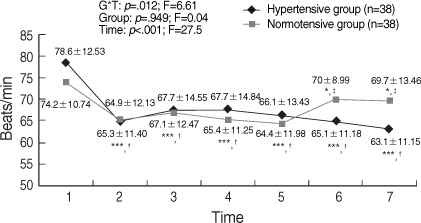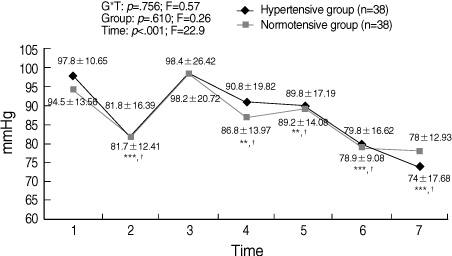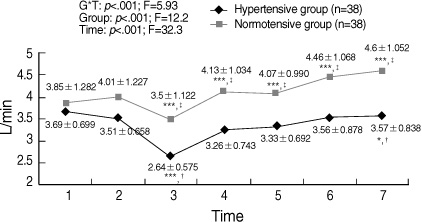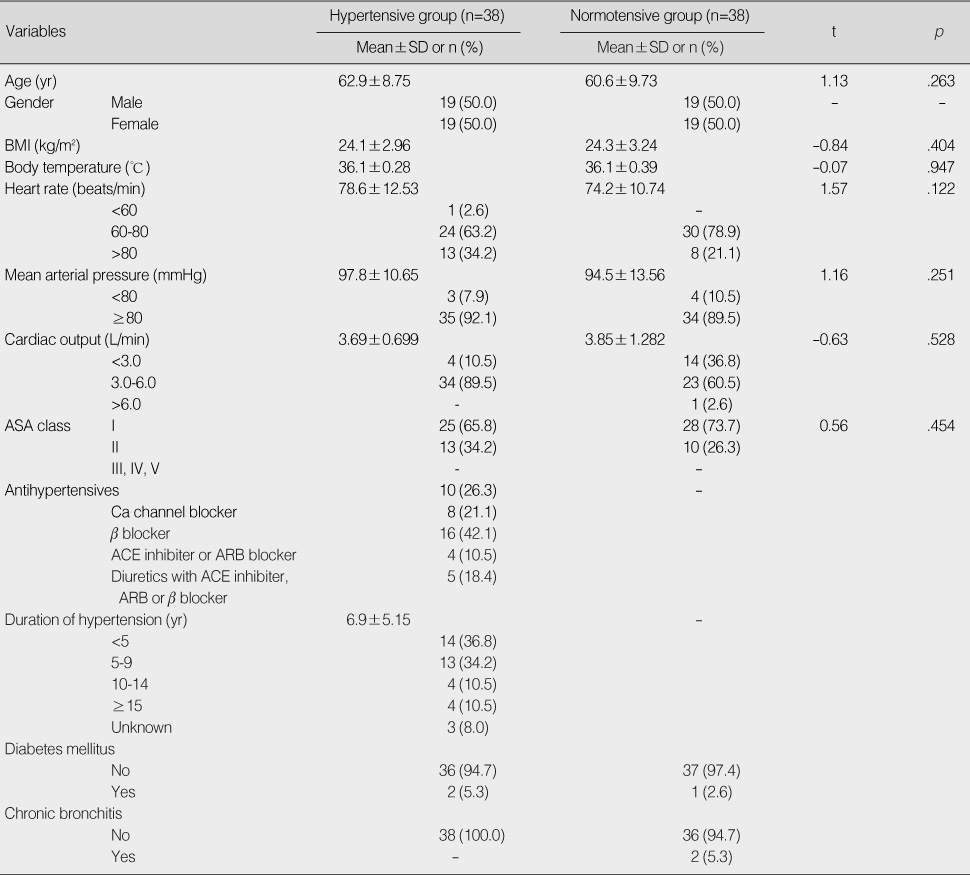Articles
- Page Path
- HOME > J Korean Acad Nurs > Volume 40(3); 2010 > Article
-
Original Article
- The Effects of Pneumoperitoneum on Heart Rate, Mean Arterial Blood Pressure and Cardiac Output of Hypertensive Patients during Laparoscopic Colectomy
- Eun Ju Kim, Haesang Yoon
-
Journal of Korean Academy of Nursing 2010;40(3):433-441.
DOI: https://doi.org/10.4040/jkan.2010.40.3.433
Published online: June 30, 2010
1Nurse Anesthetist, Department of Nursing, National Cancer Center, Ilsan, Korea.
2Professor, Department of Nursing, Gachon University of Medicine & Science, Incheon, Korea.
- Address reprint requests to: Yoon, Haesang. Department of Nursing, Gachon University of Medicine & Science, 534-2 Yeonsu-dong, Yeonsu-gu, Incheon 406-812, Korea. Tel: 82-32-820-4212, Fax: 82-32-820-4201, hsyoon@gachon.ac.kr
• Received: December 7, 2009 • Accepted: June 15, 2010
Copyright © 2010 Korean Society of Nursing Science
Abstract
-
Purpose
- This study was performed to identify effects of pneumoperitoneum on hemodynamic changes of hypertensive patients undergoing laparoscopic colectomy under general anesthesia.
-
Methods
- Data collection was done from January 2 to June 10, 2008. Seventy-six patients, including 38 hypertensive patients, who had taken antihypertensive drugs more than 1 month and 38 normotensive patients undergoing laparoscopic colectomy were enrolled in this study. The hemodynamic parameters were heart rate (HR), mean arterial pressure (MAP) and cardiac output (CO) which were measured 7 times from before induction of anesthesia to 5 min after deflation of the pneumoperitoneum. Collected data were analyzed using Repeated Measures ANOVA and Bonferroni comparison method.
-
Results
- HR in the hypertensive group was significantly decreased at deflation of the pneumoperitoneum and 5 min after deflation of the pneumoperitoneum (p=.012). MAP in the hypertensive group was not different from the normotensive group (p=.756). CO in hypertensive group was significantly lower than normotensive group (p<.001) from immediately after pneumoperitoneum to 5 min after deflation of the pneumoperitoneum.
-
Conclusion
- The results indicate that pneumoperitoneum during laparoscopic surgery does not lead to clinically negative hemodynamic changes in heart rate, mean arterial pressure or cardiac output of hypertensive patients, who have taken antihypertensive drugs for more than 1 month.
- 1. Alfonsi P, Vieillard-Baron A, Coggia M, Guignard B, Goeau-Brissonniere O, Jardin F, et al. Cardiac function during intraperitoneal CO2 insufflation for aortic surgery: A transesophageal echocardiographic study. Anesthesia and Analgesia. 2006;102:1304–1310.ArticlePubMed
- 2. Artuso D, Wayne M, Cassaro S, Cerabona T, Teixeira J, Grossi R. Hemodynamic changes during laparoscopic gastric bypass procedure. Archives of surgery. 2005;140:289–292.PubMed
- 3. Chobanian AV, Bakris GL, Black HR, Cushman WC, Green LA, Izzo JL Jr, et al. The seventh report of the joint national committee on prevention, detection, ealuation, and treatment of high blood pressure: The JNC 7 report. The Journal of the American Medical Association. 2003;289:2560–2572.PubMed
- 4. Coste C, Guignard B, Menigaux C, Chauvin M. Nitrous oxide prevents movement during orotracheal intubation without affecting BIS value. Anesthesia and Analgesia. 2000;91:130–135.ArticlePubMed
- 5. Fang F, Guo TZ, Davies MF, Maze M. Opiate receptors in the periaqueductal gray mediate analgesic effect of nitrous oxide in rats. European Journal of Pharmacology. 1997;336:137–141.ArticlePubMed
- 6. Gerges FJ, Kanazi GE, Jabbour-Khoury SI. Anesthesia for laparoscopy: A review. Journal of Clinical Anesthesia. 2006;18:67–78.ArticlePubMed
- 7. Hein HA, Joshi GP, Ramsay MA, Fox LG, Gawey BJ, Hellman CL, et al. Hemodynamic changes during laparoscopic cholecystectomy in patients with severe cardiac disease. Journal of Clinical Anesthesia. 1997;9:261–265.ArticlePubMed
- 8. Henny CP, Hofland J. Laparoscopic surgery: Pitfalls due to anesthesia, positioning, and pneumoperitoneum. Surgical Endoscopy. 2005;19:1163–1171.ArticlePubMedPDF
- 9. Ishizuka B, Kudo Y, Amemiya A, Tanii M, Aoki T. Plasma catecholamine responses during laparoscopic gynecologic surgery with CO2 insufflation. The Journal of the American Association of Gynecologic Laparoscopists. 2000;7:37–43.ArticlePubMed
- 10. Itoh H, Takeda K, Nakamura K, Fujita H, Uchida A, Kuwahara T, et al. Young borderline hypertensives are hyperreactive to mental arithmetic stress: Spectral analysis of R-R intervals. Journal of the Autonomic Nervous System. 1995;54:155–162.ArticlePubMed
- 11. Joris JL, Hamoir EE, Hartstein GM, Meurisse MR, Hubert BM, Charlier CJ, et al. Hemodynamic changes and catecholamine release during laparoscopic adrenalectomy for pheochromocytoma. Anesthesia and Analgesia. 1999;88:16–21.ArticlePubMed
- 12. Kang H, Lee IG, Cho CK, Baek CH, Park JW, Jung YH, et al. The effects of alfentanil and a combination of alfentanil and esmolol on hemodynamic responses after endotracheal intubation in hypertensive patients. Korean Journal of Anesthesiology. 2005;49:136–141.Article
- 13. Kang YW, Yoon SG, Kim EG, Lee CM, Kim KY. Comparison of laparoscopic with open resections in colorectal cancer: Analysis of short-term results. Journal of the Korean Society of Coloproctology. 2007;23:93–100.Article
- 14. Kim EA, Lee JW, Lim HS, Son JS, Ko SH. Desflurane-induced hemodynamic changes in patients with hypertension. Korean Journal of Anesthesiology. 2007;52:516–520.Article
- 15. Korean Accreditation Board of Nursing. Workshop for Education and Examination of Advanced Practice Nurse. 2007;March Seoul, Korea.
- 16. Lacy AM, García-Valdecasas JC, Delgado S, Castells A, Taurá P, Piqué JM, et al. Laparoscopy-assisted colectomy versus open colectomy for treatment of non-metastatic colon cancer: A randomised trial. Lancet. 2002;359:2224–2229.ArticlePubMed
- 17. Lee S. Cardiac output measurement. Korean Journal of Anesthesiology. 2004;46:1–9.Article
- 18. Lee YJ, Lee JU. Hemodynamic changes during the use of different general anesthetic methods in laparoscopic gynecologic surgery. Korean Journal of Anesthesiology. 2006;51:139–146.Article
- 19. Marik PE, Varon J. Hypertensive crises: Challenges and management. Chest. 2007;131:1949–1962.ArticlePubMed
- 20. Meininger D, Westphal K, Bremerich DH, Runkel H, Probst M, Zwissler B, et al. Effects of posture and prolonged pneumoperitoneum on hemodynamic parameters during laparoscopy. World Journal of Surgery. 2008;32:1400–1405.ArticlePubMedPDF
- 21. Nishikawa T, Naito H. Clonidine modulation of hemodynamic and catecholamine responses associated with hypoxia or hypercapnia in dogs. Anesthesiology. 1996;84:672–685.ArticlePubMedPDF
- 22. Noh GJ, Cho SY, Yeom JH, Shin WJ, Kim YC, Lee DH, et al. Cardiovascular and respiratory system monitoring in laparoscopic cholecystectomy. Korean Journal of Anesthesiology. 2000;39:303–308.
- 23. Park SW, Baek WY, Hong JG, Park JW, Kim BK. Changes of blood pressure and heart rate during anesthesia of hypertensive patients according to antihypertensive medication. Korean Journal of Anesthesiology. 1990;23:470–475.Article
- 24. Piccirillo G, Bucca C, Durante M, Santagada E, Munizzi MR, Cacciafesta M, et al. Heart rate and blood pressurevariabilities in salt-sensitive hypertension. Hypertension. 1996;28:944–952.ArticlePubMed
- 25. Pierson RJ, McSwiney MM. Hypertension and general anaesthesia: Guidance for general practitioners and results of a questionnaire. Anaesthesia. 2008;63:439–441.Article
- 26. Rist M, Hemmerling TM, Rauh R, Siebzehnrübl E, Jacobi KE. Influence of pneumoperitoneum and patient positioning on preload and splanchnic blood volume in laparoscopic surgery of the lower abdomen. Journal of Clinical Anesthesia. 2001;13:244–249.ArticlePubMed
- 27. Sood J, Jayaraman L, Kumra VP, Chowbey PK. Laparoscopic approach to pheochromocytoma: Is a lower intraabdominalpressure helpful? Anesthesia and Analgesia. 2006;102:637–641.ArticlePubMed
- 28. Yoon HJ, Oh JI. Correlations between mean arterial blood pressure, cardiac index, and systemic vascular resistance index in laparoscopically-assisted vaginal hysterectomy (LAVH). Korean Journal of Anesthesiology. 2005;48:45–49.Article
REFERENCES
Figure 1
Heart rate between hypertensive and normotensive group (N=76).
***p<.001; †comparison between before induction and each time; ‡comparison between hypertensive and normotensive group; G*T=Group*Time.
Time 1=before induction; Time 2=15 min after induction; Time 3=right after pneumoperitoneum; Time 4=10 min after pneumoperitoneum; Time 5=20 min after pneumoperitoneum; Time 6=right after deflation; Time 7=5 min after deflation; Score=Mean±SD.


Figure 2
Mean arterial pressure between hypertensive and normotensive group (N=76).
**p<.01; ***p<.001; †comparison between before induction and each time; G*T=Group*Time.
Time 1=before induction; Time 2=15 min after induction; Time 3= right after pneumoperitoneum; Time 4=10 min after pneumoperitoneum; Time 5=20 min after pneumoperitoneum; Time 6=right after deflation; Time 7=5 min after deflation; Score=Mean±SD.


Figure 3
Cardiac output between hypertensive and normotensive group (N=76).
*p<.05; ***p<.001; †comparison between before induction and each time; ‡comparison between hypertensive and normotensive group; G*T=Group*Time.
Time 1=right after induction; Time 2=15 min after induction; Time 3=right after pneumoperitoneum; Time 4=10 min after pneumoperitoneum; Time 5=20 min after pneumoperitoneum; Time 6=right after deflation; Time 7=5 min after deflation; Score=Mean±SD.


Figure & Data
REFERENCES
Citations
Citations to this article as recorded by 

- Non-Invasive Cardiac Output Monitoring with Electrical Cardiometry During Laparoscopic Cholecystectomy Surgery, a Cross-Sectional Study
Khaled Ahmed Yassen, Walla Aljumaiy, Imran Alherz, Lina A. AlMudayris, Sara Abdulhameed AlBunyan, Renad S. AlSubaie, Fatma Alniniya, Sherif Saleh
Journal of Clinical Medicine.2025; 14(7): 2228. CrossRef
The Effects of Pneumoperitoneum on Heart Rate, Mean Arterial Blood Pressure and Cardiac Output of Hypertensive Patients during Laparoscopic Colectomy



Figure 1
Heart rate between hypertensive and normotensive group (N=76).
***p<.001; †comparison between before induction and each time; ‡comparison between hypertensive and normotensive group; G*T=Group*Time.
Time 1=before induction; Time 2=15 min after induction; Time 3=right after pneumoperitoneum; Time 4=10 min after pneumoperitoneum; Time 5=20 min after pneumoperitoneum; Time 6=right after deflation; Time 7=5 min after deflation; Score=Mean±SD.
Figure 2
Mean arterial pressure between hypertensive and normotensive group (N=76).
**p<.01; ***p<.001; †comparison between before induction and each time; G*T=Group*Time.
Time 1=before induction; Time 2=15 min after induction; Time 3= right after pneumoperitoneum; Time 4=10 min after pneumoperitoneum; Time 5=20 min after pneumoperitoneum; Time 6=right after deflation; Time 7=5 min after deflation; Score=Mean±SD.
Figure 3
Cardiac output between hypertensive and normotensive group (N=76).
*p<.05; ***p<.001; †comparison between before induction and each time; ‡comparison between hypertensive and normotensive group; G*T=Group*Time.
Time 1=right after induction; Time 2=15 min after induction; Time 3=right after pneumoperitoneum; Time 4=10 min after pneumoperitoneum; Time 5=20 min after pneumoperitoneum; Time 6=right after deflation; Time 7=5 min after deflation; Score=Mean±SD.
Figure 1
Figure 2
Figure 3
The Effects of Pneumoperitoneum on Heart Rate, Mean Arterial Blood Pressure and Cardiac Output of Hypertensive Patients during Laparoscopic Colectomy
Homogeneity Test for Physiological Characteristics (N=76)
BMI=Body mass index; ASA=American Society of Anesthesiology; ACE=angiotensin converting enzyme; ARB=Angiotensin II Receptor Blocker.
Table 1
Homogeneity Test for Physiological Characteristics (N=76)
BMI=Body mass index; ASA=American Society of Anesthesiology; ACE=angiotensin converting enzyme; ARB=Angiotensin II Receptor Blocker.
 KSNS
KSNS
 E-SUBMISSION
E-SUBMISSION

 Cite
Cite

